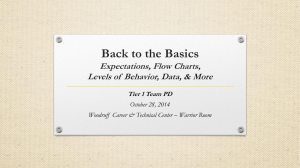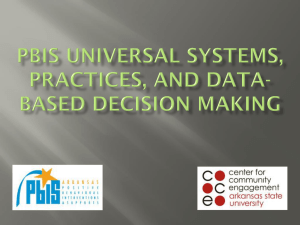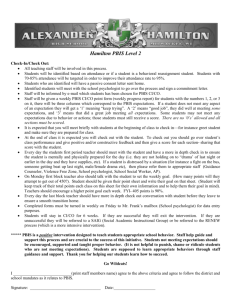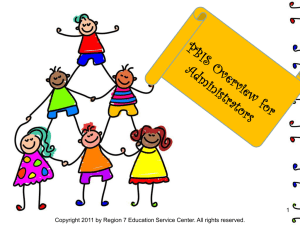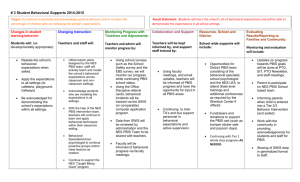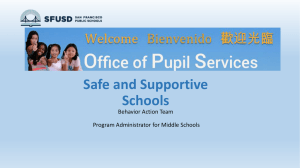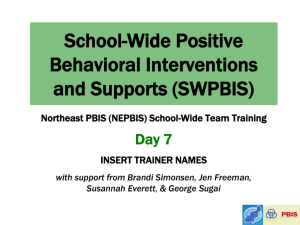Inclusive Practice Tool: Positive Behavioral Interventions and Supports
advertisement
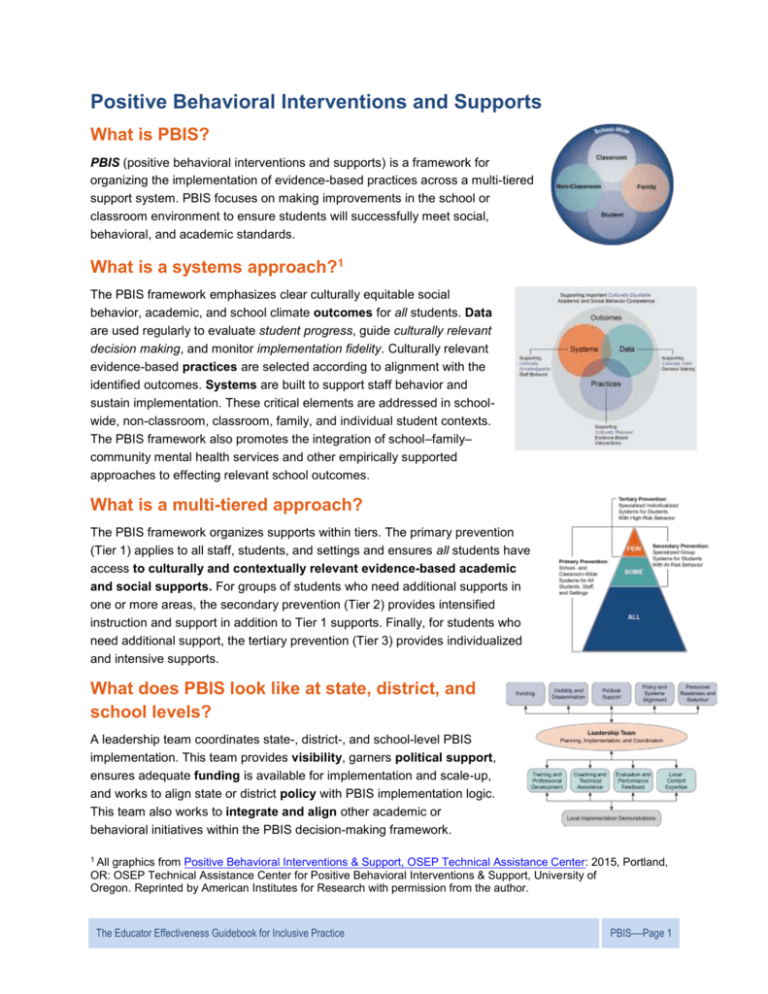
Positive Behavioral Interventions and Supports What is PBIS? PBIS (positive behavioral interventions and supports) is a framework for organizing the implementation of evidence-based practices across a multi-tiered support system. PBIS focuses on making improvements in the school or classroom environment to ensure students will successfully meet social, behavioral, and academic standards. What is a systems approach?1 The PBIS framework emphasizes clear culturally equitable social behavior, academic, and school climate outcomes for all students. Data are used regularly to evaluate student progress, guide culturally relevant decision making, and monitor implementation fidelity. Culturally relevant evidence-based practices are selected according to alignment with the identified outcomes. Systems are built to support staff behavior and sustain implementation. These critical elements are addressed in schoolwide, non-classroom, classroom, family, and individual student contexts. The PBIS framework also promotes the integration of school–family– community mental health services and other empirically supported approaches to effecting relevant school outcomes. What is a multi-tiered approach? The PBIS framework organizes supports within tiers. The primary prevention (Tier 1) applies to all staff, students, and settings and ensures all students have access to culturally and contextually relevant evidence-based academic and social supports. For groups of students who need additional supports in one or more areas, the secondary prevention (Tier 2) provides intensified instruction and support in addition to Tier 1 supports. Finally, for students who need additional support, the tertiary prevention (Tier 3) provides individualized and intensive supports. What does PBIS look like at state, district, and school levels? A leadership team coordinates state-, district-, and school-level PBIS implementation. This team provides visibility, garners political support, ensures adequate funding is available for implementation and scale-up, and works to align state or district policy with PBIS implementation logic. This team also works to integrate and align other academic or behavioral initiatives within the PBIS decision-making framework. 1 All graphics from Positive Behavioral Interventions & Support, OSEP Technical Assistance Center: 2015, Portland, OR: OSEP Technical Assistance Center for Positive Behavioral Interventions & Support, University of Oregon. Reprinted by American Institutes for Research with permission from the author. The Educator Effectiveness Guidebook for Inclusive Practice │PBIS—Page 1 In addition, the team coordinates all training, coaching, and evaluation activities and provides content expertise to guide implementation. Local school and district demonstrations are developed, and implementation is scaled up across schools and districts over time. What does PBIS look like at the school-wide, classroom, and individual student levels? School-wide, class-wide, and individual student PBIS use the same logic and seek to improve the teaching, learning, and social environment to support student academic and behavioral success. All staff members and students (school-wide) or classroom teachers and students (class-wide) identify relevant academic, social, or behavioral outcomes and plan for multi-tiered supports across all school settings (school-wide) or routines and activities (class-wide). Data are used regularly to evaluate student progress across settings (school-wide) or routines and activities (class-wide), guide culturally relevant decision making, and monitor implementation fidelity. Contextually and culturally relevant evidence-based practices are selected based on alignment with the identified outcomes. Systems are built school-wide to support and sustain teachers’ implementation of these practices. Practices and supports for individual students follow the same multi-tiered logic of PBIS especially by prioritizing access to all opportunities available within the classroom and across all school settings. At this level, assessments, intervention planning, and implementation involve greater precision, engagement, and intensity. A function-based approach is used to develop and implement individual behavior plans, and a wraparound approach is taken to integrate family, community, and school supports. Evidence-based behavior support includes the following key Tier 1 practices and features2 School-Wide ■ Develop a positively stated social behavioral purpose statement ■ Post, define, teach, and encourage three to five positive school-wide expectations ■ Provide a continuum of procedures for responding to rule violations and reteaching prosocial alternatives ■ Use team-based decision making and implementation coordination ■ Use data-based decision making to monitor implementation fidelity and student progress Class-Wide ■ Effectively design the physical environment of the classroom ■ Develop and teach predictable classroom routines ■ Post, define, and teach three to five positive classroom expectations ■ Actively engage students in observable ways with high rates of varied opportunities to respond, prompts, and active supervision ■ Acknowledge expected behavior with specific praise ■ Use brief, specific, instructional error corrections to correct inappropriate behaviors ■ Provide a continuum of supports to both support appropriate behavior and correct inappropriate behavior Individual Student ■ Use function-based assessment and behavior intervention planning ■ Select and implement evidence-based and individualized behavioral practices ■ Conduct comprehensive and universal screening for risk and strengths ■ Continuously monitor progress ■ Use team-based decision making and implementation coordination ■ Use data-based decision making to monitor implementation fidelity and student progress 2 Simonsen, B., Fairbanks, S., Briesch, A., Myers, D., & Sugai, G. (2008). A review of evidence-based practices in classroom management: Considerations for research to practice. Education and Treatment of Children, 31, 351–380. The Educator Effectiveness Guidebook for Inclusive Practice │PBIS—Page 2

